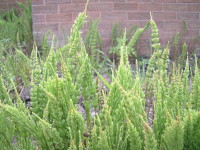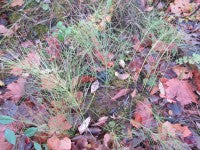Horsetail - An attractive nuisance!

Identifying the enemy
Horsetail is a perennial with creeping, rhizomatous stems, which can penetrate two metres into the soil.
Much of the spread of the plant is vegetative via these rhizomes, but a sexual fruiting stem carrying a sporulating fruiting body emerges in the early spring to about 25cm in height. The stem is brownish white and hollow, terminating in a cone-like structure bearing sporangia on their scales.

Barren pale green, jointed vegetative stems emerge from April onwards, extending to 30-60cm in height and bearing slender, simple branches in place of leaves in whorls of up to twelve. It is these stems which are increasingly seen as a problem in waste ground, non-cropped areas and gardens.
Most species of Equisetum are poisonous to livestock by virtue of alkaloids and the enzyme Thiaminase, which destroys Vitamin B1 and causes animals to suffer from Vitamin B1 deficiency. Horsetails are usually avoided by grazing livestock, but should never be fed to livestock in hay or silage.
Going into battle
Drainage in wet areas, liming where necessary and repeated cutting of the vegetative shoots can all contribute to controlling the weed. In practice, frequent cutting would take years to exhaust the rhizomes. Cutting of the spore-bearing shoots before sporulation also helps minimise new plants.

Choose your weapons
MCPA and 2,4,D give control of aerial shoots, but re-growth from rhizomes occurs the following year. The contact herbicide glufosinate ammonium is also claimed to give control. Sowing intervals need to be carefully observed with all these herbicides.
Control with Roundup ProBio
Thick layers of silica and wax make the cuticle very difficult to penetrate with herbicides, and the needle-like 'branches' present a very small area for interception of spray. This physical barrier, combined with a large area of underground storage organs, mean this weed is usually classed as resistant or only moderately susceptible to glyphosate.
To maximise control in areas where an alternative residual weed control is not possible, or where re-cropping of the area is planned, it may be necessary to use a non-residual, environmentally acceptable herbicide, and the following approaches will optimise control with Roundup:
Foliar spray
Use a modern formulation of Roundup, like Pro Bio with its superior wetters.
Wait until the vegetative shoots have reached maximum height (60cm) and opened out, usually July.
Bruise the stems lightly immediately before treatment. This will break the waxy layer and allow much better penetration of the glyphosate. To achieve this, small areas can be brushed with a stiff broom; field areas are best with a Cambridge roller. (The bruising must not be severe enough to break off the stems!)
Apply the highest rate of Roundup Pro Bio recommended - i.e. 10 l/ha in 100-200 litres water, with a droplet size on the finer side of medium. In a knapsack, this rate is 50ml per litre of water sprayed to just before run-off.
Weedwiper
A weedwiper with one part Roundup Pro Bio to two parts water could also be used and the effect of wiping itself can help in the bruising process.
On small areas, or where the weed is encroaching amongst other desirable plants, the use of a weed wiping glove can also prove a very successful method of bruising and application at the same time.
Stem injection
Where the infestation is in a position where spraying is not practical, or to eliminate the last few stems after previous spray treatments, a stem injection method can be adopted. Although it is labour intensive, there may be situations where it is justified.

Cut stems should be removed from grazing areas before stock are returned.
For more information visit the website: www.monsanto-ag.co.uk contact the Technical Helpline on 01954 717575 or e-mail technical.helpline.uk@monsanto.com
